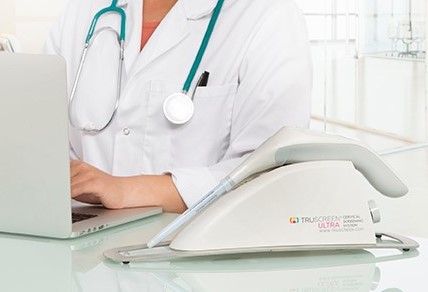Biotech Daily TruScreen Article

TRUSCREEN (FORMERLY POLARTECHNICS)
Truscreen chief executive officer Martin Dillon says the new, improved version of the company’s Truscreen cervical cancer test can be a primary screening tool.
In Melbourne with chairman Tony Ho and chief financial officer Guy Robertson on a non-deal roadshow, Mr Dillon told Biotech Daily that in the decade since Polartechnics failed to commercialize the original Truscreen diagnostic, the New Zealand-based company had redeveloped it to be wireless, portable and connect to all smart mobile telephones and computer systems, providing immediate, single-visit diagnosis.
In 2008, Mr Dillon’s brother, Ben Dillon, was the chief executive officer of Polartechnics and the company had announced increasing sales, but by 2010 it was in the hands of receivers, having failed to raise funds and merge with another cancer diagnostic company Fermiscan (BD: Aug 14, Dec 10, 2008; Jul 16, 2009; Feb 11, 2010).
Today, Martin Dillon said that the technology worked by emitting light and an electric current to stimulate the cervix which “creates a tissue signature and reports whether it is normal or abnormal”.
Mr Dillon said that Truscreen’s sensitivity and specificity were “in the high seventies or low eighties and as good as a [Papanicolaou] test in a first world hospital”.
Mr Dillon said that a direct comparison had been trialed at Sydney’s Royal Hospital for Women an “it is expected the results will show that Truscreen is as good as a Pap test at a public teaching hospital”.
He said that Truscreen was aimed at the developing world where laboratory facilities were out of the physical and financial reach of many women.
Mr Dillon said Truscreen was available in China, India and Mexico and had been tested for regulatory approval in each country and other target markets included Russia, Africa, the Middle East and Latin America.
Mr Dillon said that 300,000 women died each year from cervical cancer and effective screening could reduce the fatalities.
He said that the device was Conformité Européenne (CE) mark approved for primary screening and would be sold to hospitals, clinics as well as government and non-governmental organization (NGO) programs, with the costs in the developing world “generally underwritten by government and NGOs”.
Mr Dillon said the addressable market was $NZ166 million ($A160.2 million) a year and in the 12 months to February 28, 2019, sales were up 175 percent to $NZ2.2 million.
He said that Truscreen had a distributor network in 31 countries and had sold 268 devices with 150,000 single use sensors sold in the 12 months to February 28, 2019.
Mr Dillon said that Truscreen had cash and cash equivalents of $NZ1.3 million.
Mr Ho said that the company expected to list on the ASX in August or September this year with an initial public offer to raise $5 million to $8 million to expand the commercialization of the diagnostic.
On the NZX, Truscreen closed untraded at 14.8 NZ cents (14.3 Australian cents).
You can view the full article in its PDF format on the link below.
BD-Biotech-Daily-Mar-19-Truscreen.PDF